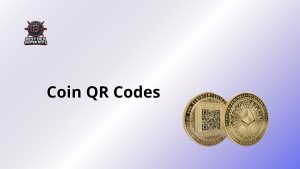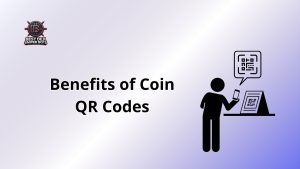Coin QR codes are transforming how we interact with cryptocurrencies, collectibles, and business promotions by embedding scannable Quick Response (QR) codes into physical or digital coins. These codes simplify transactions, connect physical items to digital content, and enhance user engagement. From streamlining blockchain payments to linking commemorative coins to websites, coin QR codes bridge the physical and digital worlds. This article explores their definition, applications, benefits, and future potential, offering a comprehensive, SEO-optimized guide for crypto enthusiasts, businesses, and collectors.
Contents
Defining Coin QR Codes
Coin QR codes are two-dimensional barcodes integrated into physical coins or generated by cryptocurrency wallets to encode data like wallet addresses, payment details, or website links. Invented in 1994 by Denso Wave for tracking automotive parts, QR codes have evolved into a versatile tool. In cryptocurrencies, they enable users to scan a code with a smartphone to send or receive digital assets, avoiding manual entry of complex wallet addresses. Beyond crypto, QR codes on physical coins link to digital content, such as historical archives or marketing campaigns.
For example, a Bitcoin wallet might generate a QR code with a user’s public address, while a collectible coin could direct scanners to a website with event details. This technology enhances usability and interactivity across industries.
Applications of Coin QR Codes
The applications of coin QR codes are diverse, spanning cryptocurrency, collectibles, and marketing. Key uses include:
Streamlining Cryptocurrency Payments
QR codes simplify crypto transactions by encoding wallet addresses. Long, alphanumeric addresses are prone to errors when typed manually, but scanning a QR code with a wallet app (e.g., Coinbase, MetaMask) ensures accuracy and speed. For instance, a coffee shop accepting Bitcoin might display a QR code at the register, allowing customers to pay instantly, making crypto payments practical for everyday use.
Enhancing Commemorative Coins
Physical coins and currency increasingly feature QR codes. In 2011, the Royal Dutch Mint issued a centenary coin with a QR code linking to a historical website. Nigeria’s 2014 100-naira note and Russia’s 2015 100-rubles note for Crimea’s annexation included QR codes for digital content. These coins become collectibles with added digital value, appealing to enthusiasts and historians.
Boosting Marketing Campaigns
Businesses use QR codes on custom challenge coins to drive engagement. X-1FBO, for example, created coins with unique QR codes linking to a contest entry form for a $500 Amazon gift card raffle. Companies can also engrave QR codes on coins to link to websites, social media, or vCard details, functioning as innovative business cards that enhance brand visibility.
Enriching Gaming Experiences
In gaming, QR codes on coins unlock digital rewards. Yo-kai Watch players scan codes at in-game locations like Piggleston Bank to obtain items or characters, such as Red Coins or Traveler’s Coins. This creates an interactive bridge between physical collectibles and digital gameplay, enhancing user experiences.
Crypto Collectibles
Physical coins with QR codes encoding crypto addresses or messages are popular among enthusiasts. Cryptochips.io offers custom coins made of high-density iron with a copper finish, displaying wallet addresses, website links, or messages when scanned. These serve as collectibles, gift cards, or promotional tools, combining aesthetic and functional value.
Benefits of Coin QR Codes
Coin QR codes offer several advantages:
- User-Friendly: Scanning a QR code is faster and easier than typing a crypto address, making transactions accessible to novices.
- Accuracy: QR codes eliminate errors from manual address entry, reducing the risk of sending funds to the wrong destination.
- Security: Codes from trusted sources minimize phishing or address poisoning risks, though verifying authenticity is essential to avoid scams.
- Versatility: QR codes support major cryptocurrencies like Bitcoin, Ethereum, and Litecoin and can be customized for marketing or personal use.
- Speed: Transactions via QR codes are nearly instantaneous, ideal for retail or peer-to-peer payments, like splitting a restaurant bill.
- Engagement: For businesses and collectors, QR codes create interactive experiences by linking to contests, websites, or exclusive content.
Creating Coin QR Codes
Generating coin QR codes is simple for both crypto and promotional purposes:
For Crypto Transactions:
- Copy your public wallet address from a wallet app (e.g., Trust Wallet, MetaMask).
- Use a trusted QR code generator like Me-QR, Cwallet, or QR Code Dynamic. Paste the address, add optional details like amount or message, and customize if desired.
Download the QR code as an image or print it for use.
For Physical Coins:
- Partner with a manufacturer like Cryptochips.io or Signature Coins to engrave a QR code onto a custom coin. Provide the link, address, or message (up to 240–420 characters).
- Opt for static QR codes for crypto addresses or dynamic ones for editable marketing links.
Test the QR code with a small transaction or scan to ensure accuracy before widespread use.
Challenges to Consider
Despite their benefits, coin QR codes have challenges:
- Security Risks: Malicious QR codes can lead to fraudulent addresses. Always verify the source, especially for crypto transactions, to avoid scams.
- Scanability Issues: Complex QR codes, like those with Lightning invoices, may be hard for some devices to scan. Simple designs improve compatibility.
- Durability: Physical coins must use durable materials to maintain QR code scannability. High-density iron or copper finishes are common.
- Privacy Concerns: Public QR codes may expose wallet addresses, so use them cautiously for sensitive transactions.
Mitigate these by using trusted generators, testing codes, and ensuring secure distribution.
The Future Potential of Coin QR Codes
The future of coin QR codes is promising as cryptocurrency adoption grows. Posts on X highlight their use in peer-to-peer payments, such as with Pi Network, enabling bank-free global transactions. Dynamic QR codes, which allow editable links, could expand marketing and collectible applications. Unified BIP21 QR codes for Bitcoin, combining on-chain and Lightning payments, promise simpler user experiences.
Businesses may increasingly adopt QR codes for crypto payments at retail, with ATMs and point-of-sale systems integrating them. Collectors could see more commemorative coins with QR codes linking to blockchain-based NFTs or historical archives, blending physical and digital value.
Best Practices for Coin QR Codes
To leverage coin QR codes effectively:
- Verify Sources: Use reputable QR code generators and confirm crypto addresses to prevent fraud.
- Test Compatibility: Scan QR codes with multiple devices to ensure they work seamlessly.
- Simplify Designs: Avoid complex patterns to maintain scannability.
- Protect Physical Coins: Store QR-coded coins in safe conditions to prevent damage.
- Educate Users: Guide recipients on scanning QR codes for smooth transactions or interactions.
How Can Coin QR Codes Enhance Your Crypto Experience?
Coin QR codes simplify cryptocurrency transactions, enrich collectibles, and boost business engagement with speed and interactivity. From error-free crypto payments to linking physical coins to digital content, their potential is vast. As technology and adoption evolve, these codes will play a key role in bridging physical and digital worlds. How will you integrate coin QR codes into your crypto or marketing strategy in 2025?

